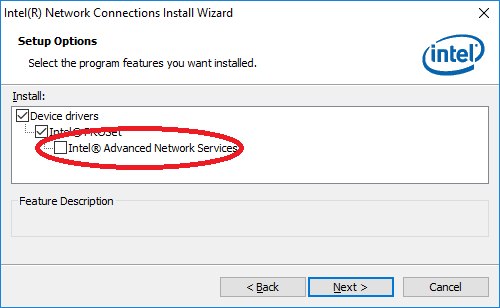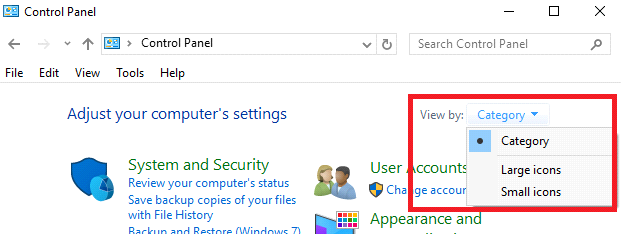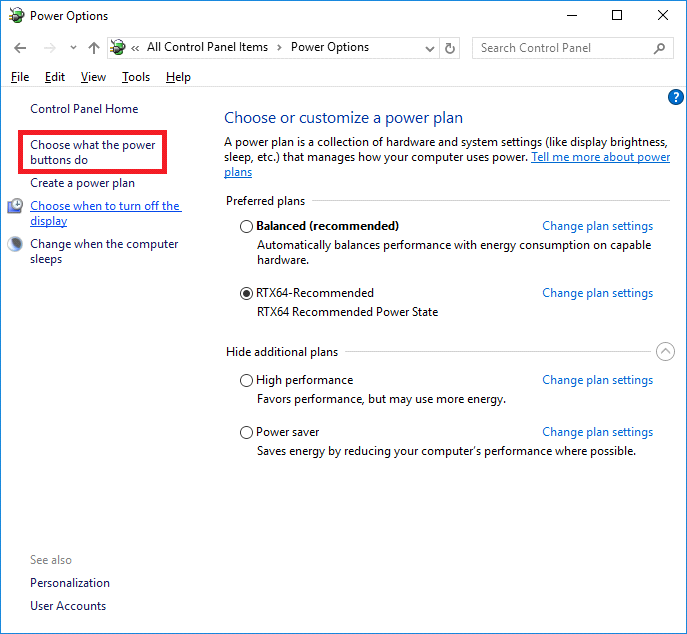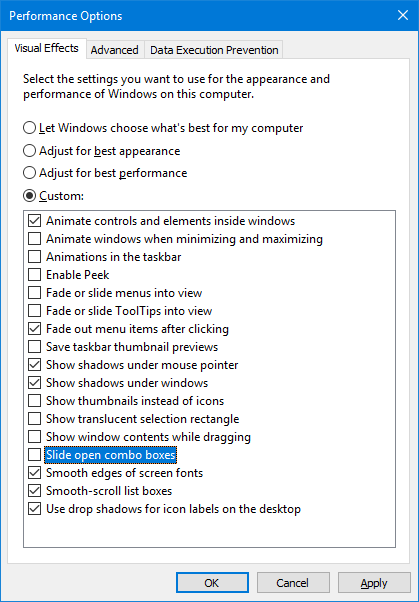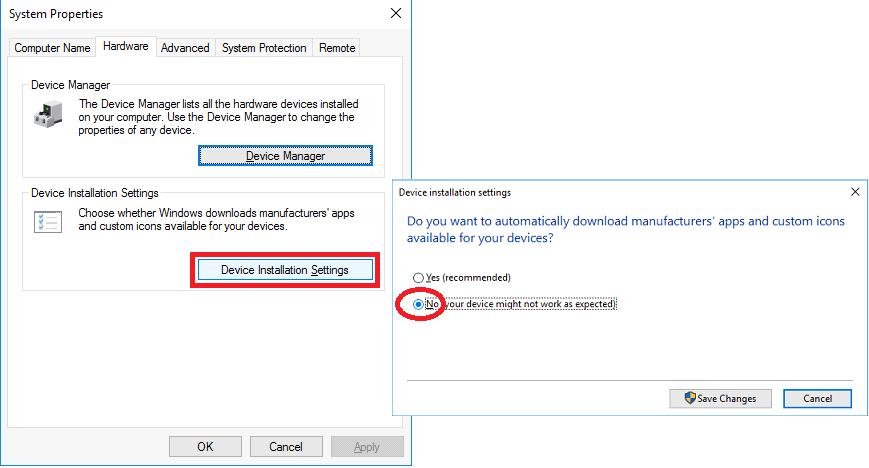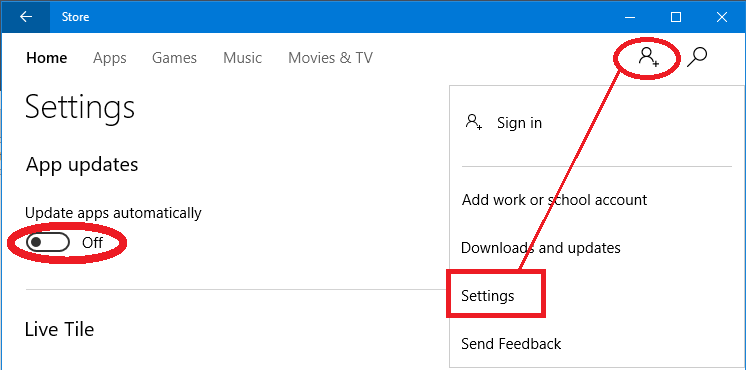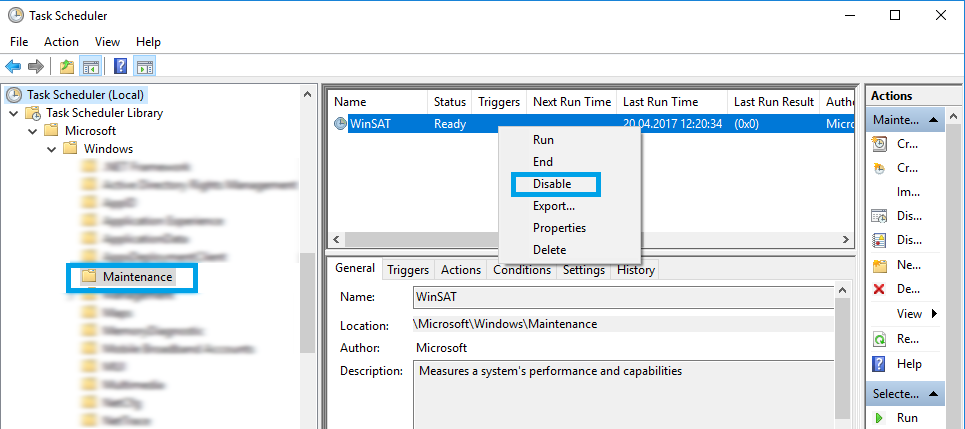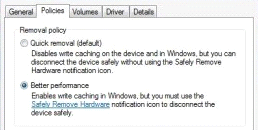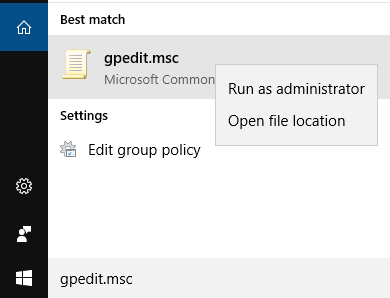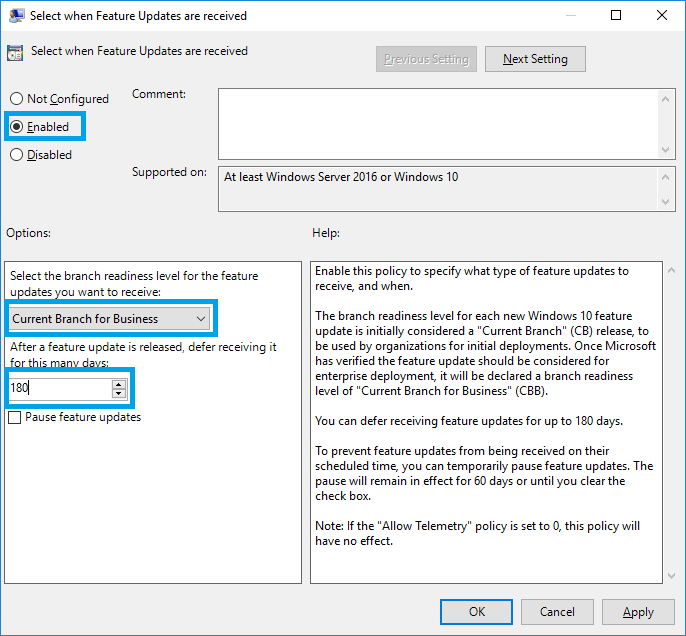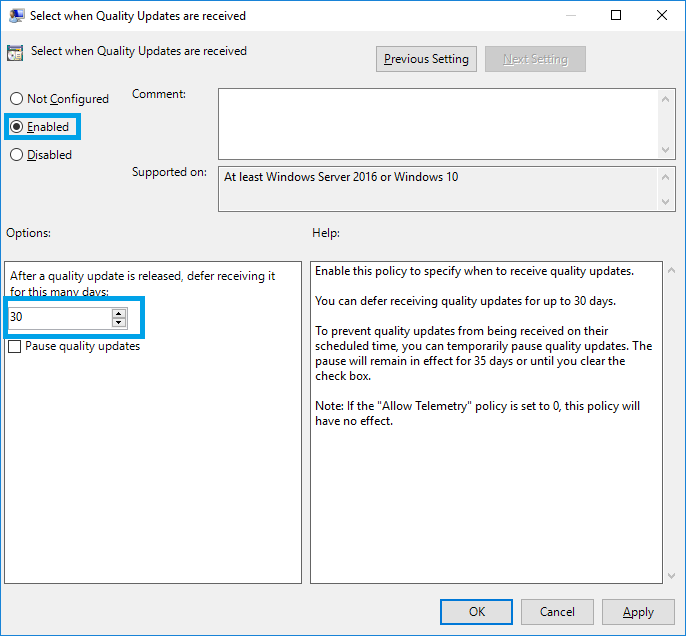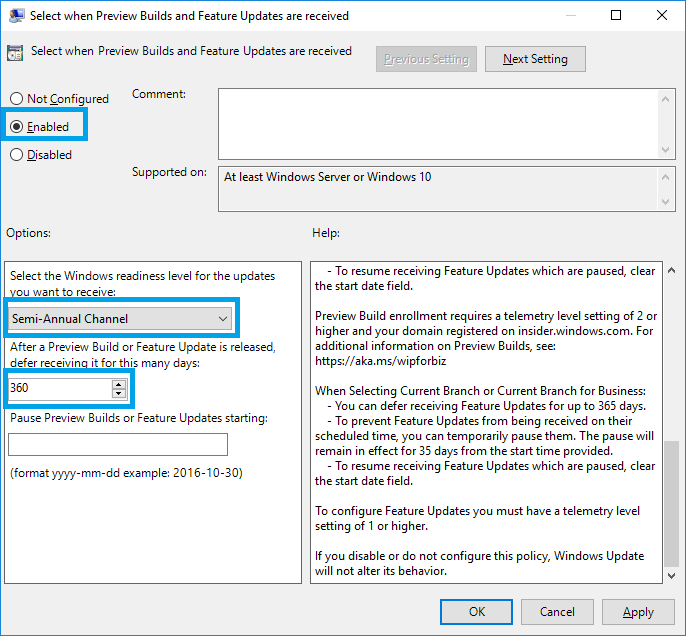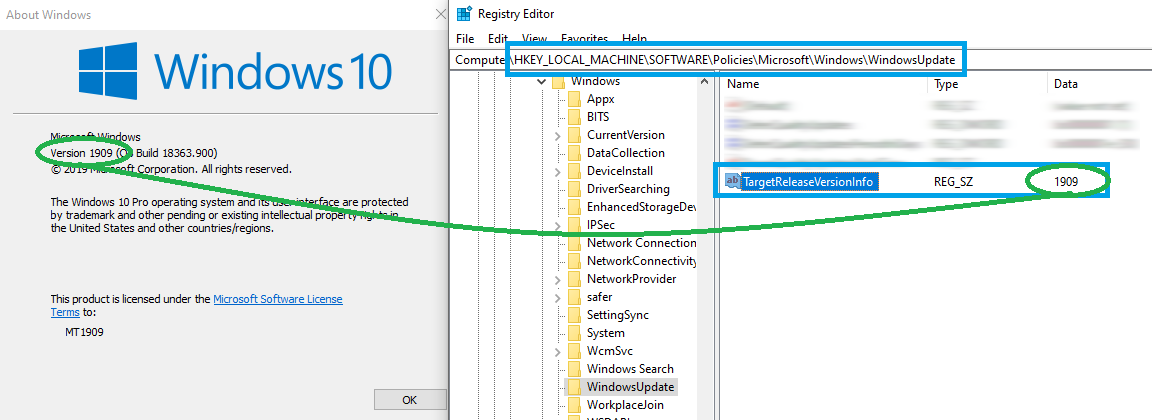Windows 10 Configuration
Windows has been designed for a wide variety of applications. Unfortunately that means that, out-of-the-box, it works correctly for office or entertainment applications, but for DAW applications, several settings and features have to be fine-tuned.
Native users should also refer to this page for additional recommendations.
Windows 10 Fall Creator (1709) : Pyramix 11.0.6 / Ovation 7.0.6 / VCube 7.0.6 / AMR 11.0.6 required
Windows 10 Spring Creator (1803) : Pyramix 11.1.4 / Ovation 7.1.4 / VCube 7.1.4 / AMR 11.1.4 required. (MassCore mode : RTX64 3.4 version)
Windows 10 October 2018 (1809) : Pyramix 11.1.6 / Ovation 7.1.6 / VCube 7.1.6 / AMR 11.1.6 required. (MassCore mode : RTX64 3.6.2 version)
Windows 10 May 2019 (1903) : Pyramix 12.0.5 - Pyramix 14.0 / Ovation 8.1.5 - Ovation 10.0 / VCube 8.1.5 - VCube 10.0 / AMR 12.0.5 - AMR14 required. (MassCore mode : RTX64 3.7 version)
Windows 10 November 2019 update (1909) : Pyramix 12.0.5 - Pyramix 14.0 / Ovation 8.1.5 - Ovation 10.0 / VCube 8.1.5 - VCube 10.0 / AMR 12.0.5 - AMR14 required. (MassCore mode : RTX64 3.7 version)
Windows 10 May 2020 (2004): Pyramix 25th Hotfix 3 - Pyramix 14.0 / Ovation 9.0.6 - Ovation 10.0 / VCube 9.0.6 - VCube 10.0 / AMR 13.0.6 - AMR14. (MassCore mode : RTX64 3.7.4 version)
Windows 10 Fall 2020 (20H2) : Pyramix 25th Hotfix 3 - Pyramix 14.0 / Ovation 9.0.6 - Ovation 10.0 / VCube 9.0.6 - VCube 10.0 / AMR 13.0.6 - AMR14. (MassCore mode : RTX64 3.7.4 version)
Windows 10 May 2021 (21H1) : Pyramix 25th Hotfix 3 - Pyramix 14.0 / Ovation 9.0.6 - Ovation 10.0 / VCube 9.0.6 - VCube 10.0 / AMR 13.0.6 - AMR14. (MassCore mode : RTX64 3.7.4 version)
Windows 10 November 2021 (21H2) : Pyramix 25th Hotfix 3 - Pyramix 14.0 / Ovation 9.0.6 - Ovation 10.0 / VCube 9.0.6 - VCube 10.0 / AMR 13.0.6 - AMR14. (MassCore mode : RTX64 3.7.4 version)
Windows 10 November 2022 (22H2) : Pyramix 25th Hotfix 3 - Pyramix 14.0 / Ovation 9.0.6 - Ovation 10.0 / VCube 9.0.6 - VCube 10.0 / AMR 13.0.6 - AMR14. (MassCore mode : RTX64 3.7.4 version)
Windows Editions : Pro or Enterprise (Home editions not tested)
Merging highly recommends you "defer feature updates" in Windows 10, see Updates section below.
1.BIOS
If you can access your computer BIOS, it is recommended to disable all power management features of your CPU, as this implies changes in the CPU speed and that is far from optimal for any audio application.
Same applies to overclocking.
Please have a look at your motherboard manual to locate those settings, may vary depending of the manufacturer.
Intel Turbo Boost Technology: Disabled
CPU Enhanced Halt (C1E): Disabled
C-State Support (C3, C6, C7, C8 State): all Disabled
CPU EIST Function: Disabled (also called Intel Enhanced SpeedStep, that should always be disabled)
CPU power saving mode: Disabled
MassCore users : Secure Boot option is not supported, please disable this feature in your BIOS.
2.WINDOWS CONFIGURATION
During Windows installation, please take the time to customize your installation and select the required additional features.
Diagnostic Data to Microsoft can be set to "Basic".
If you don’t have a Microsoft account, you can click on “skip this step” at the bottom of the page when Windows prompt you for your Microsoft account.
Merging recommends you don’t activate Cortana now, but configure it later once the OS is installed.
Version 1809/1903 only:
Select "Offline Account" to use a standard local account rather than an online Microsoft account.
A note on drag & drop and Run as Administrator in Windows 10.
In Windows 10, when you run a program by forcing it in “administrator mode” / “Run as administrator”, drag & drop to and from this application will be disabled.
DEVICE DRIVERS
Merging recommends to install WHQL (Driver certified by Microsoft) or if not available, the latest drivers from the manufacturer website.
Install the drivers ONLY, do not install the utilities it can cause much trouble.
Do not install Intel® Control Center that is included in Intel® Rapid Storage Technology installer or Intel® Management Engine installer.
WARNING: Since PMX V11/ Ovation V7, MassCore users running a RAID configuration must use a dedicated RTX dongle (SSK-HUD-RTX) to authorize MassCore.
This issue only affects the system (Windows ) RAID drives, if you have RAID Data drives, a dedicated dongle is not required.
Do not install the RealTek Ethernet Diagnostic utility.
For MassCore users : do not install Intel® Advanced Network Services included in Intel® LAN driver, it may slow down the whole system.
GRAPHIC CARD DRIVERS
Please install your graphic card driver.
It is mandatory to configure the driver according to the Merging Graphic Cards recommended settings page.
Not properly configured drivers may trigger glitches and drops !
WINDOWS CONTROL PANEL
To access Windows 10 Anniversary (1607) Control Panel, right click on Windows Start and select Control Panel.
On other Windows 10 versions (since 1703), type "control panel" in Windows Search box.
You can right click on the control panel icon from the search result and pin it to the Start menu or Taskbar.
For ease of use, it is recommended to set the Control Panel to Small Icons.
Disable Windows User Account Control (UAC)
User Accounts > Change User Account Control settings > set it to Never notify. > OK.
View hidden files, folders and drives and show file extensions in Windows Explorer
File Explorer Options > View tab :
Hidden files and folders : set it to Show hidden files, folders or drives
Hide empty drives : disable
Hide extensions for known file types : disable
Leave Hide protected operating system files (recommended) active
Power Options
MassCore and RAVENNA ASIO/ Merging Audio Device users have to first disable the "Fast Startup feature", which indeed put the computer to sleep when you select shut down.
Click on "Choose what the power buttons do” on the left hand side of Power options page.
Then click on "Change Settings that are currently unavailable" and uncheck the "Turn on fast startup" option. Click on Save Changes. Note also that hibernate / sleep is not supported by MassCore engine.
This is also not supported by the Ovation / Pyramix ADR keyboard.
In the main Power options page :
Native users : Set the power scheme to High Performance or Ultimate Performance (version 1803 and above)
If the Ultimate Performance power plan is not available:
Open a command prompt (CMD) and paste the following line :
powercfg -duplicatescheme e9a42b02-d5df-448d-aa00-03f14749eb61
Hit Enter, the power plan will be added to the list.
MassCore users : Set the power scheme RTX – recommended.
Native & MassCore : then Change plan settings
Screen Saver (Turn off the display) is usually set to Never. If you are recording, you surely don’t want the display to turn off after several minutes!
Put the computer to sleep must be set to Never
Access Change advanced power settings and make sure that:
Hard Disk > Turn off Hard disk after: Never
Desktop background settings > Slide show: Paused
Sleep > Sleep after: Never / Allow hybrid sleep: off / Hibernate after: Never / Allow wake timers: Disable.
USB Settings > USB selective suspend setting: Disabled
PCI Express > Link State Power Management: Off
Processor power management > System Cooling policy : Active
Minimum and Maximum processor state: 100%
ADDITONAL CONFIGURATION FOR LAPTOPS & NATIVE USERS
Laptops usually have very few BIOS options to prevent CPU power management issues.
But several settings are accessible in Windows, but are hidden.
Download this zip file and double click on the extracted reg file.
Two new options will be displayed in Processor power management.
Set Allow Throttle States to Off and Processor performance boost mode to Disabled.
Sound
Windows can notify the user of some vents by playing a sound.
If your ASIO device is also used by Windows to play its sounds, it may cause audio drops as it will access the device.
In that case it is recommended to access the Sounds tab and set the Sound Scheme to No Sounds.
Spring Creator : Sound settings have moved in Windows Settings > System > Sound
System > Advanced System Settings
Windows 20H2 Users :
The Control Panel > System is no longer accessible.
Please type advanced system settings in Windows search field (next to Windows Start button) to access those pages.
Advanced tab > Performance
Click on the Settings button in the Performance section.
Visual Effects tab
Those settings have to be disabled to prevent system peaks:
Animate Windows when minimizing and maximizing : disable
Animations in the taskbar and Start Menu : disable
Enable Peek : disable
Fade or slide menus / ToolTips into view : disable
Save taskbar thumbnail previews : disable
Show translucent selection rectangle: disable
Show window content while dragging: disable
Slide open Combo boxes: disable
A dedicated graphic card is highly recommended for advanced display configuration, including video or Mixer window in Pyramix, Ovation or VCube.
Advanced tab
Processor Scheduling should be set to Background Services for Native ASIO users.
Data Execution Prevention tab
If you can't access this setting (greyed out), it is set on its default configuration, "Turn on DEP for essential Windows programs and services only", and is correctly configured.
If you have access to this setting, set it to "Turn on DEP for essential Windows programs and services only".
System Protection tab
Back in the main System windows, switch to System Protection tab:
Make sure protection is turned on for your system drive.
Select the system drive and click on Configure.
Select Turn on system protection, and set a value for Disk Space Usage (usually 10% max).
Disable the system protection on the Media drive(s), as this feature only works on system files and programs.
Hardware tab
Back in the main System windows, switch to Hardware tab:
Click on Device Installation Settings and select the “No, let me choose what to do" option.
This will prevent Windows update service to automatically change the system drivers.
Windows Firewall
By default, Merging applications are authorized to communicate through the Windows Firewall.
In case of issue, RAVENNA Users can disable the Windows Firewall (for Public Networks).
If you use another firewall, authorize the required applications or disable it on your RAVENNA network.
WINDOWS SETTINGS
Settings page can be accessed through Windows Start > Settings icon (and + i)
System
- (1803 and above) Display > Graphic settings : graphic performances can be configured per application.
Select "Classic App" and browse to C:/Program Files/Merging Technologies.
Add Pyramix.exe - Ovation.exe - VCube.exe depending on your configuration.
Then select the application(s) and click on Options, set the graphics preference to High Performance. - (2004 and above) Display > Graphic settings : Hardware accelerated GPU Scheduling. Merging recommends to enable this feature if available on your system (depends on the graphic card capabilities).
- In Notifications & actions, you can configure which quick action tile and notification will be displayed (edit your quick actions)
Merging recommends to only have “All settings” & “Network” tiles active.
In the Notifications section, you can configure how and which application can send Notifications.
Merging recommends to disable the “Get tips, tricks, and suggestions as you use Windows”, "Suggest ways I can finish setting up my device..." and "Show me the Windows welcome experience..." for better performance. - Focus assist can be configured to remove several Windows notifications. (1803 and above)
- Tablet: Merging recommends you set it to Never use tablet mode and don't switch to tablet mode.
- Multitasking : Merging recommends to set all Snap options to off, especially for computers not using dedicated graphic cards.
Switching between Virtual desktops is not recommended during real time operation.
In the Timeline section, Merging recommends you disable the "show suggestions occasionally in the timeline". (Spring Creator) - (1809) Clipboard : you can activate the Clipboard history feature (to save multiple items in Windows clipboard).
Note : This feature is only applicable to few Windows applications for the moment. - Remote desktop : since Spring Creator update, remote desktop is disabled by default.
Note : Remote desktop is not supported in MT Security panel, you cannot import keys through remote desktop.
Personalization
Windows transparency can cause issues, especially on systems with low graphic resources.
Go in Settings > Personalization > Colors.
Turn "Make Start, taskbar, and action center transparent" or "Transparency effects" to Off.
Start menu, Taskbar and notification area can be configured in Settings > Personalization > Start and Taskbar.
Merging recommends to disable the “Occasionally show suggestions in start” option for the Start menu (to prevent Windows downloading apps without notifications).
In the Taskbar section, disable the "Use Peek to preview the desktop ...."
(Since 1709) You may disable the People icon in the taskbar through Windows Settings > Personnalization > Taskbar > Show contacts on the taskbar : Off.
Apps & Features
In Apps and features, uninstall all unnecessary applications.
(In Windows 10 Anniversary 1607, Apps are only accessible through Settings > System)
Some applications cannot be uninstalled (Mail and Calendar for example), uninstall button will be disabled.
Bonjour is required for Merging products, do not uninstall it.
Merging recommends you uninstall Xbox Live (Fall Creator and following) and Xbox (1903 and following).
You may also remove Feedback Hub, Get Office, Microsoft Solitaire Collection, Paid Wifi&Mobile, Print3D (Fall Creator), Skype and Tips.
Startup : Please do not disable RTX64Bootcheck (RTX64 System Tray can be disabled).
Gaming (Since Creator Update)
In Game Bar, set "Record game clips, screenshots..." to off, and disable "Open Game bar ..." and "Show Game bar when I play ..."
In Game DVR, set both "Background recording" and "Recorded Audio" to off.
In Game Mode, set "Use Game Mode" to off.
(Fall Creator) In TruePlay, set "True Play" to off.
Privacy
In General, Merging recommends you turn off "Show me suggested content in the Settings app".
"Let apps use my advertising ID ...." should be turned off, to reduce the OS internet traffic.
In Background Apps, Merging recommends you only enable the required apps for better performance. You may also turn it off.
(1803) In Activity history, Merging recommends you disable both "Let Windows collect my activities from this PC" and "Let Windows sync my activities from this PC to the cloud"
(1809) In Activity History : "Send my activity history to Microsoft" should be turned off, to reduce the OS internet traffic.
(1803 and above) In File System, "Allow Apps to access your file system" has to be turned on (default).
Search
Since 1903, you may configure Search to search your entire PC (disabled by default). Please note that this search mode will increase the CPU consumption.
This can be set in Search > Searching Windows : Enhanced mode.
Since 2004, a new Indexer Performance - Respect device Power Mode Settings is available. Merging recommends you let this setting to Off, as this will increase CPU consumption.
Update & Security
(In Windows 10 Anniversary, Windows Defender is only accessible through Windows Control Panel > Windows Defender.)
Full Virus Scanning should not run at the same time as Merging software.
If you plan to install an Antivirus software, Windows Defender will be disabled.
You should also disable scanning of the Pyramix files (pmx, pmf, pml, pad, pmw) but also media files (wav, aif, flac, mp3,...), because each time the DAW have to access such file, your antivirus may scan it.
AVAST has already caused a lot of problems with several Merging programs, it is therefore not recommended.
See this page for help on configuring your antivirus exceptions.
Windows Defender users can download and run a script to include the required rules in Windows Defender.
MTWindowsDefenderExclusions.zip
Windows Defender automatic scans have to be configured in Windows Task scheduler.
Go in Windows Control Panel > Administrative Tools > Task Scheduler.
Browse the Task scheduler library to Microsoft > Windows > Windows Defender.
Right click on the Windows Defender Scheduled Scan task and select Properties.
in the Conditions tab, set it to Start only if the computer is idle, and Stop if the computer ceases to be idle.
in Windows Settings > Update & Security, select Windows Security.
In Virus & Threat Protection > Virus & Threat Protection settings, the Controlled folder access feature should be left to default.
In App & browser control, the Exploit protection feature should be left to default (some third party drivers may not install otherwise)
ADDITIONAL CONFIGURATIONS
Cortana configuration
Cortana can be disabled (recommended but optional)
In Windows Search field, type GPEDIT.MSC
Right click on the gpedit.msc and select Run as Administrator
Browse to Computer Configuration > Adminsistrative Templates > Windows Components > Search and set Allow Cortana to disabled.
If you want to keep Cortana, please configure it :
Fall Creator (1709) / Spring Creator (1803) / October 2018 (1809) :
Cortana can be configured through Windows Settings > Cortana.
In the Talk to Cortana page, set "Let Cortana respond to Hey Cortana" and"Use Cortana even when my device is locked" to off.
In Permissions & History, set "Windows Cloud Search" to off. Turning off ""View activity history", "My device history" and "Activity recommendations"(1809 only) is optional.
May 2019 (1903) / November 2019
Cortana can be configured through Windows Settings > Cortana.
In the Talk to Cortana page, set "Let Cortana respond to Hey Cortana" and"Use Cortana even when my device is locked" to off.
In Permissions > Manage the information Cortana can access from this device, Merging recommends you set all to off.
In Windows Settings > Search > Permissions & History, set "Windows Cloud Search" to off. Turning off "My device history" is optional.
Taskbar
Right click on the taskbar to access its configuration.
Merging recommends you turn off the News and interests, and disable Show Cortana and Show Taskview.
Taskview may cause glitches if used during real-time operation, it is therefore recommended to not use it while recording or other critical operation.
Windows Store Apps auto-update
Merging recommends you disable the auto updates on Windows Apps, for better performance.
Open Windows Store, and click on the profile icon on the top right corner and select settings (On Spring Creator, click on the ... icon)
Set “Update apps automatically” or "App updates" (depending on your Windows Store version).
OneDrive configuration / uninstall
If you use OneDrive, you should configure it to not interfere in the network traffic.
Right click on the OneDrive icon in the notification area and select Settings.
Remove "Start OneDrive Automatically when I sign to Windows" and "Display notifications when people share with me or edit my shared files".
In the Network tab, set both Upload and Download rates to Limit to : 125 KB/s (or lower).
If you don't use OneDrive, you may uninstall it in Windows Settings > System > Apps and features.
System Recovery
To be able to use the Windows System Restore feature, you first need to configure it, in Windows Control Panel > Recovery : Configure System Restore.
You should only enable the protection on the system drive : select the system drive then click on Configure.
Set "Turn on system protection", then configure the Disk Space usage (usually around 10% is sufficient).
WinSAT
In Windows 10, Windows System Assessment Tool (WinSAT) is scheduled to run too often compared to previous Windows version, and this tool is not very useful. Its main purpose is to calculate the system rating displayed in Windows Control panel > System page, but it can also re-activate some setting without noticing the user.
If WinSAT runs during real-time operations, you can experience drop outs and CPU/Core peaks, therefore Merging recommends you disable it, or configure it to run only if the system is idle.
Go in Windows Control Panel > Administrative Tools > Task Scheduler.
Browse the Task scheduler library to Microsoft > Windows > Maintenance.
Right click on the WinSAT task and select Disable.
If you don't want to disable it, access its Properties, then in the Conditions tab, set it to Start only if the computer is idle, and Stop if the computer ceases to be idle.
Laptop – Battery saver
Windows 10 introduces a new battery saver feature that conserves your PC's battery by limiting background activity and adjusting hardware settings. This feature can cause serious performance issues.
Merging recommends you disable the Battery Saver during recordings and critical real time operations.
Go in Windows Settings, and select System > Battery.
Set Battery saver is currently to Off.
This setting will be grayed out if the PC is currently plugged in to AC.
You may still set the Battery saver on if your battery falls below a specified %.
Activate the “Turn battery saver on automatically if my battery falls below” and set a value (Merging recommends 10 %).
Laptops usually have small graphical resources, Merging recommends you pay extra caution when using the Fixed Cursor option.
WINDOWS DEVICE MANAGER
Ports (COM & LPT)
If you use 9pin-RS422 connection:
Communication Port (COM x) > Properties
Ports Settings tab > Advanced > set both Receive and Transmit buffer to Low (4)
Universal Serial Bus controllers
Check each USB Root Hub / Host controller and disable power management if any, by right clicking on it and accessing its properties.(Power Management tab)
Network Adapters
Right click on your network adapter and access its properties to disable the power management features:
Disable Energy Efficient Ethernet and Green Ethernet, and all Power Saver / Power management features.
RAVENNA ASIO users have to set WOL & Shutdown Link Speed to Not Speed Down.
For better performance, RAVENNA ASIO users should use a dedicated RAVENNA network adapter.
Find more details on this page.
Please also follow the Native recommendations from this page.
MEDIA DRIVES
By default; Windows will index the content of all drives, which allows Windows Search to work faster.
But this indexing task takes CPU power and can result in performance issue when recording.
To disable the Windows indexing, open My Computer, right click on the Media Drive(s) and select Properties: disable Allow files on this drive to have contents indexed in addition to file properties checkbox.
NEVER USE “Compress this drive to save disk space”.
External drives: access your external drive properties through Windows Device Manager and set it to optimize for performance.
Format block size: if you only use audio files, the best size is 64 Kb when formatting the drive.
But if you also need to use video files, 64Kb is not the optimal size, in that case keep the Default Allocation size (128Kb).
The best way is to use separate drives for video and audio, if possible.
SYSTEM CONFIGURATION (MSCONFIG)
Many installed programs have associated background services, which usually can then start faster, or get updates automatically. But this uses memory and CPU power, so you should only run useful programs.
!!!Be careful, if you remove an essential program or service, Windows may not start anymore !!!
Windows Control Panel > Administrative Tools > System Configuration:
The boot menu timeout can be changed in the Boot tab (min 3 seconds).
Services Tab
Check the box Hide all Microsoft services, those are critical for Windows.
Service Bonjour is critical for RAVENNA networks and Virtual Transport.
Do not disable your graphic card and ASIO card driver or service.
Common services that can be disabled are: printer services, Skype, QuickTime updaters ...
Startup
Open the link to Task Manager to access the list.
Do not disable Microsoft Windows Operating System or any other critical driver – program for your system.
Common programs that can be disabled are Adobe Reader, Java updater, Skype, QuickTime...
Those programs will be still be installed and accessible, but will not be loaded during Windows startup.
WINDOWS UPDATE
One of the main issue with Windows 10 is that Microsoft wants the OS to always be up to date.
That means, by default, you do not have control anymore if you want to apply updates or not.
As in previous versions, sometimes an update can go wrong, and Windows can become unusable.
Hopefully it is still possible to get control under the hood.
Please note that it will only works on Pro or Enterprise versions, not on Home editions.
Automatic Updates configuration
If you want to follow the Microsoft update policy, you should at least defer the Windows updates.
Merging highly recommends you defer updates in Windows 10, as major Windows updates can make your system unusable.
This allows such updates to be further tested and approved by Microsoft, and Merging.
Updates can be configured on Pro, Educational or Enterprise editions of Windows, not on home versions!
You may also rather Pause the updates for 30 days, follow this page for detailed instructions.
Pyramix 11.0.6 / Ovation 7.0.6 / VCube 7.0.6 / AMR 7.0.6 required for Windows 10 1709.
Pyramix 11.1.4 / Ovation 7.1.4 / VCube 7.1.4 / AMR 11.1.4 required for Windows 10 1803.
Pyramix 11.1.6 / Ovation 7.1.6 / VCube 7.1.6 / AMR 11.1.6 required for Windows 10 1809.
Pyramix 12.0.5 / Ovation 8.0.5 / VCube 8.0.5 / AMR 12.0.5 required for Windows 10 1903 and 1909.
Pyramix 25th / Ovation 9.0.3 / VCube 9.0.3 /AMR 13.0.3 compatible with Windows 10 November 2019 Update 1909
Pyramix 25th Hotfix 3 / Ovation 9.0.6 / VCube 9.0.6 /AMR 13.0.6 (or above) compatible with Windows 10 2004
Pyramix 25th Hotfix 3 / Ovation 9.0.6 / VCube 9.0.6 /AMR 13.0.6 (or above) compatible with Windows 10 20H2
Pyramix 25th Hotfix 3 / Ovation 9.0.6 / VCube 9.0.6 /AMR 13.0.6 (or above) compatible with Windows 10 21H1
Pyramix 25th Hotfix 3 / Ovation 9.0.6 / VCube 9.0.6 /AMR 13.0.6 (or above) compatible with Windows 10 21H2
Pyramix 25th Hotfix 3 / Ovation 9.0.6 / VCube 9.0.6 /AMR 13.0.6 (or above) compatible with Windows 10 22H2
Configure updates using Group Policy Editor
Windows Anniversary (1607), Creator (1703), Fall Creator (1709), Spring Creator (1803) October 2018 Update (1809) May 2019 Update (1903) November 2019 Update (1909) May 2020 (2004) Fall 2020 (20H2) May 2021 (21H1), November 2021 (21H2)
In Windows Search field, type GPEDIT.MSC
Right click on the gpedit.msc and select Run as Administrator
Prevent Windows 10 update to new Major version
Since Windows 1803, it is possible to prevent Windows 10 to upgrade to a new major version.
Such update will not be automatically downloaded and installed on your computer, but it is still possible to update manually, with Microsoft Update Assistant.
(MassCore users should first make sure that the MassCore engine is compatible before upgrading to a new Windows version - see this page).
Please note that Merging can't guarantee that this setting will continue to work with new Windows 10 versions.
According to Microsoft "it will work until the policy is changed to a newer Windows 10 feature update.”
- Download and extract the following zip file
- Double click on the WindowsTargetReleaseVersionInfo.reg file to add it to your Windows registry
- Open Windows Registry Editor (Regedit.exe) and browse to HKEY_LOCAL_MACHINE\SOFTWARE\Policies\Microsoft\Windows\WindowsUpdate
- Double click on WindowsTargetReleaseVersionInfo and enter your current Windows version.
You can easily get your current Windows version by typing winver in Windows search field or Run command.
Note for MassCore users above 22H1
MassCore users with the latest Windows 10 versions will still have a warning message upon opening Pyramix.
This is due to a no longer present registry key checked at Pyramix's launch. To remedy this :
- Download the "Branch Readiness Level" key : https://download.merging.com/beta/SupportTools/MTBranchReadiness.zip
- Extract the zip
- From Windows search, open "regedit" as administrator
- Click "File>Import>Select the unzipped key"
- Hit ok
Feature vs Quality updates ?
Quality Update provides fixes but no new functionality while the Feature Update provides new features.
You can also configure Windows to restart outside of active hours :
Go in Windows Start > Settings > Update and security > Windows update.
In Update settings, click on Change active hours and set it according to your needs.
This prevents Windows to restart the computer, but it still downloads the updates.
Go now in Advanced Options, and check the "Defer feature updates" : this will defer updates, allowing only widely tested updates to be applied on your computer.
Click on the "Learn more" button for further details.
Defer Updates is highly recommended, as several big feature updates can make your system unusable.
Additional configuration
In both case, Merging recommends you disable updates from other computers (your computer can receive, but also send updates directly to other computers, costing computer resources and network bandwidth) .
Go in Windows Settings > Update & Security > Windows Update > Advanced options > Delivery Optimization.
“Allow downloads from other PCs” should be set to off.
DPC LATENCY CHECK
To handle real time application, the CPU gets a defined amount of time to perform the required tasks.
If those tasks are delayed, the result is usually drop-outs in the signal.
A common tool to verify if your computer is able to handle real-time audio was DPC Latency Checker, but the reported values are false in Windows 8 and 10.
The alternative solution is to use the LatencyMon tool,
Download the tool and install it on your computer.
You can start the test by clicking on the Play icon on the top left corner.
To get useful results, the tool should run for quite some time (10 minutes minimum).
The driver or process using the highest DPC or ISR is clearly stated in the main window.
If you have too high values, you can get more detailed information in the Processes or Drivers tab.
Don't pay too much attention to the hard pagefault resolution time (last indicator)
If you have higher values, you will have to search for the driver/ device that is causing the issue by disabling them one by one.
Remember that some devices cannot be disabled, proceed with caution.
Wi-Fi, Bluetooth, LAN specific (usually ndis.sys),USB devices, on-board audio, PCI / PCIe devices are the common culprits.
On laptops, the ACPI battery driver is also a common problem (ACPI.sys), you can try to disable (do not uninstall!) the "Microsoft ACPI Compliant Control Method Battery" and "Microsoft AC Adapter" listed under Batteries in Windows Device Manager (but pay attention to not disable any other ACPI device listed under System devices, your computer may not start anymore !)
Note on Wi-Fi and Bluetooth : If you have DPC issues related to Wi-Fi and/or Bluetooth, not only the driver might be the culprit, but also the stability of the Wi-Fi network (if the signal is not stable, the Wi-Fi adapter constantly have to work which will introduce DPC latencies) or the Bluetooth devices connected to your computer. Therefore this means that if Wi-Fi does not cause DPC issue in one place, it could in another place with unstable Wi-Fi. Same applies to Bluetooth, it may cause DPC issues with certain devices only.
Be careful if you want to use Wi-Fi and/or Bluetooth on your computer.
Settings to apply when creating a user on an already configured system
Windows 10 Tip :Creating a new user account without Microsoft ID
1.Use Local Users and Groups :
In Windows Start Search field, type lusrmgr.msc to access the console.
You can easily add local users, and configure if they are part of Users or Administrators groups.
2.Go in Settings > Accounts and click on "Other people" in the left hand pane.
Click on "Add someone else to this PC".
In the next page, select "I don't have this person's sign-in information", then "Add a user without Microsoft account".
